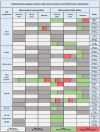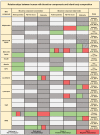Relationships between the Intakes of Human Milk Components and Body Composition of Breastfed Infants: A Systematic Review
- PMID: 37242254
- PMCID: PMC10223764
- DOI: 10.3390/nu15102370
Relationships between the Intakes of Human Milk Components and Body Composition of Breastfed Infants: A Systematic Review
Abstract
Human milk provides all of the elements necessary for infant growth and development. Previous studies have reported associations between breastfeeding and a reduced risk of developing obesity and late-onset metabolic disorders; however, the underlying mechanisms are poorly understood. Recently, intakes of human milk components have been associated with infant body composition, which is likely partially implicated in the reduced risk of developing childhood obesity among breastfed infants. In this systematic review, we searched electronic bibliographic databases for studies that explored relationships between the 24 h intakes of human milk macronutrients and bioactive components and infant body composition and/or growth parameters. Of 13 eligible studies, 10 assessed relationships of infant body composition and growth outcomes with human milk macronutrients, while 8 studies assessed relationships with human milk bioactive components. Significant time-dependent relationships with infant anthropometrics and body composition were found for intakes and no relationships for concentrations of several human milk components, such as lactose, total protein, and human milk oligosaccharides, suggesting that measuring concentrations of human milk components without quantifying the intake by the infant may provide a limited understanding. Future studies investigating the effect of human milk components on infant growth and body composition outcomes should consider measuring the actual intake of components and employ standardised methods for measuring milk intake.
Keywords: bioactive molecules; breastfeeding; dose; early life nutrition; growth; human milk intake; infant body composition; lactation; macronutrients; systematic review.
Conflict of interest statement
D.T.G. declares participation in the Scientific Advisory Board of Medela AG. A.S., D.T.G., C.T.L., I.N., J.L.M., S.L.P., V.S.S. and Z.G. are/were supported by an unrestricted research grant from Medela AG, administered by The University of Western Australia. Umm Al–Qura University, Saudi Arabia, provides a Ph.D scholarship for A.S. The funders had no role in the design of the study; in the collection, analyses, or interpretation of data; in the writing of the manuscript; or in the decision to publish the results.
Figures





References
Publication types
MeSH terms
Grants and funding
LinkOut - more resources
Full Text Sources
Medical

